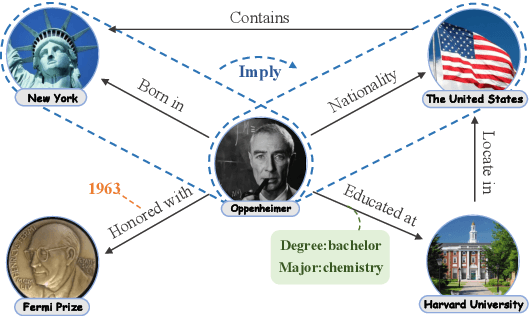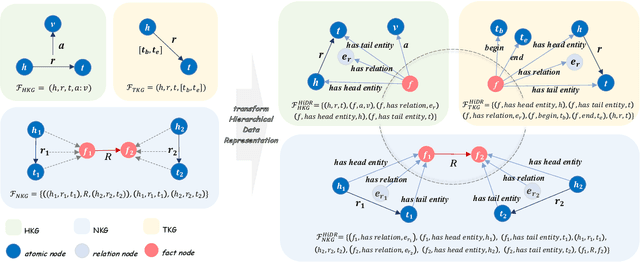Zhiqiang Liu
OneEval: Benchmarking LLM Knowledge-intensive Reasoning over Diverse Knowledge Bases
Jun 14, 2025Abstract:Large Language Models (LLMs) have demonstrated substantial progress on reasoning tasks involving unstructured text, yet their capabilities significantly deteriorate when reasoning requires integrating structured external knowledge such as knowledge graphs, code snippets, or formal logic. This limitation is partly due to the absence of benchmarks capable of systematically evaluating LLM performance across diverse structured knowledge modalities. To address this gap, we introduce \textbf{\textsc{OneEval}}, a comprehensive benchmark explicitly designed to assess the knowledge-intensive reasoning capabilities of LLMs across four structured knowledge modalities, unstructured text, knowledge graphs, code, and formal logic, and five critical domains (general knowledge, government, science, law, and programming). \textsc{OneEval} comprises 4,019 carefully curated instances and includes a challenging subset, \textsc{OneEval}\textsubscript{Hard}, consisting of 1,285 particularly difficult cases. Through extensive evaluation of 18 state-of-the-art open-source and proprietary LLMs, we establish three core findings: a) \emph{persistent limitations in structured reasoning}, with even the strongest model achieving only 32.2\% accuracy on \textsc{OneEval}\textsubscript{Hard}; b) \emph{performance consistently declines as the structural complexity of the knowledge base increases}, with accuracy dropping sharply from 53\% (textual reasoning) to 25\% (formal logic); and c) \emph{diminishing returns from extended reasoning chains}, highlighting the critical need for models to adapt reasoning depth appropriately to task complexity. We release the \textsc{OneEval} datasets, evaluation scripts, and baseline results publicly, accompanied by a leaderboard to facilitate ongoing advancements in structured knowledge reasoning.
Beyond Completion: A Foundation Model for General Knowledge Graph Reasoning
May 28, 2025Abstract:In natural language processing (NLP) and computer vision (CV), the successful application of foundation models across diverse tasks has demonstrated their remarkable potential. However, despite the rich structural and textual information embedded in knowledge graphs (KGs), existing research of foundation model for KG has primarily focused on their structural aspects, with most efforts restricted to in-KG tasks (e.g., knowledge graph completion, KGC). This limitation has hindered progress in addressing more challenging out-of-KG tasks. In this paper, we introduce MERRY, a foundation model for general knowledge graph reasoning, and investigate its performance across two task categories: in-KG reasoning tasks (e.g., KGC) and out-of-KG tasks (e.g., KG question answering, KGQA). We not only utilize the structural information, but also the textual information in KGs. Specifically, we propose a multi-perspective Conditional Message Passing (CMP) encoding architecture to bridge the gap between textual and structural modalities, enabling their seamless integration. Additionally, we introduce a dynamic residual fusion module to selectively retain relevant textual information and a flexible edge scoring mechanism to adapt to diverse downstream tasks. Comprehensive evaluations on 28 datasets demonstrate that MERRY outperforms existing baselines in most scenarios, showcasing strong reasoning capabilities within KGs and excellent generalization to out-of-KG tasks such as KGQA.
Multi-modal Knowledge Graph Generation with Semantics-enriched Prompts
Apr 18, 2025Abstract:Multi-modal Knowledge Graphs (MMKGs) have been widely applied across various domains for knowledge representation. However, the existing MMKGs are significantly fewer than required, and their construction faces numerous challenges, particularly in ensuring the selection of high-quality, contextually relevant images for knowledge graph enrichment. To address these challenges, we present a framework for constructing MMKGs from conventional KGs. Furthermore, to generate higher-quality images that are more relevant to the context in the given knowledge graph, we designed a neighbor selection method called Visualizable Structural Neighbor Selection (VSNS). This method consists of two modules: Visualizable Neighbor Selection (VNS) and Structural Neighbor Selection (SNS). The VNS module filters relations that are difficult to visualize, while the SNS module selects neighbors that most effectively capture the structural characteristics of the entity. To evaluate the quality of the generated images, we performed qualitative and quantitative evaluations on two datasets, MKG-Y and DB15K. The experimental results indicate that using the VSNS method to select neighbors results in higher-quality images that are more relevant to the knowledge graph.
OntoTune: Ontology-Driven Self-training for Aligning Large Language Models
Feb 08, 2025



Abstract:Existing domain-specific Large Language Models (LLMs) are typically developed by fine-tuning general-purposed LLMs with large-scale domain-specific corpora. However, training on large-scale corpora often fails to effectively organize domain knowledge of LLMs, leading to fragmented understanding. Inspired by how humans connect concepts and organize knowledge through mind maps, we aim to emulate this approach by using ontology with hierarchical conceptual knowledge to reorganize LLM's domain knowledge. From this perspective, we propose an ontology-driven self-training framework called OntoTune, which aims to align LLMs with ontology through in-context learning, enabling the generation of responses guided by the ontology. We leverage in-context learning to identify whether the LLM has acquired the specific concept's ontology knowledge, and select the entries not yet mastered by LLM as the training set to further align the LLM with ontology. Compared to existing domain LLMs based on newly collected large-scale domain-specific corpora, our OntoTune, which relies on the existing, long-term developed ontology and LLM itself, significantly reduces data maintenance costs and offers improved generalization ability. We conduct our study in the medical domain to evaluate the effectiveness of OntoTune, utilizing a standardized medical ontology, SNOMED CT as our ontology source. Experimental results demonstrate that OntoTune achieves state-of-the-art performance in both in-ontology task hypernym discovery and out-of-ontology task medical domain QA. Moreover, compared to the latest direct ontology injection method TaxoLLaMA, our OntoTune better preserves original knowledge of LLM. The code and data are available at https://github.com/zjukg/OntoTune.
Focusing Image Generation to Mitigate Spurious Correlations
Dec 27, 2024



Abstract:Instance features in images exhibit spurious correlations with background features, affecting the training process of deep neural classifiers. This leads to insufficient attention to instance features by the classifier, resulting in erroneous classification outcomes. In this paper, we propose a data augmentation method called Spurious Correlations Guided Synthesis (SCGS) that mitigates spurious correlations through image generation model. This approach does not require expensive spurious attribute (group) labels for the training data and can be widely applied to other debiasing methods. Specifically, SCGS first identifies the incorrect attention regions of a pre-trained classifier on the training images, and then uses an image generation model to generate new training data based on these incorrect attended regions. SCGS increases the diversity and scale of the dataset to reduce the impact of spurious correlations on classifiers. Changes in the classifier's attention regions and experimental results on three different domain datasets demonstrate that this method is effective in reducing the classifier's reliance on spurious correlations.
CP-UNet: Contour-based Probabilistic Model for Medical Ultrasound Images Segmentation
Nov 21, 2024Abstract:Deep learning-based segmentation methods are widely utilized for detecting lesions in ultrasound images. Throughout the imaging procedure, the attenuation and scattering of ultrasound waves cause contour blurring and the formation of artifacts, limiting the clarity of the acquired ultrasound images. To overcome this challenge, we propose a contour-based probabilistic segmentation model CP-UNet, which guides the segmentation network to enhance its focus on contour during decoding. We design a novel down-sampling module to enable the contour probability distribution modeling and encoding stages to acquire global-local features. Furthermore, the Gaussian Mixture Model utilizes optimized features to model the contour distribution, capturing the uncertainty of lesion boundaries. Extensive experiments with several state-of-the-art deep learning segmentation methods on three ultrasound image datasets show that our method performs better on breast and thyroid lesions segmentation.
UniHR: Hierarchical Representation Learning for Unified Knowledge Graph Link Prediction
Nov 11, 2024



Abstract:Beyond-triple fact representations including hyper-relational facts with auxiliary key-value pairs, temporal facts with additional timestamps, and nested facts implying relationships between facts, are gaining significant attention. However, existing link prediction models are usually designed for one specific type of facts, making it difficult to generalize to other fact representations. To overcome this limitation, we propose a Unified Hierarchical Representation learning framework (UniHR) for unified knowledge graph link prediction. It consists of a unified Hierarchical Data Representation (HiDR) module and a unified Hierarchical Structure Learning (HiSL) module as graph encoder. The HiDR module unifies hyper-relational KGs, temporal KGs, and nested factual KGs into triple-based representations. Then HiSL incorporates intra-fact and inter-fact message passing, focusing on enhancing the semantic information within individual facts and enriching the structural information between facts. Experimental results across 7 datasets from 3 types of KGs demonstrate that our UniHR outperforms baselines designed for one specific kind of KG, indicating strong generalization capability of HiDR form and the effectiveness of HiSL module. Code and data are available at https://github.com/Lza12a/UniHR.
Incorporating Group Prior into Variational Inference for Tail-User Behavior Modeling in CTR Prediction
Oct 19, 2024


Abstract:User behavior modeling -- which aims to extract user interests from behavioral data -- has shown great power in Click-through rate (CTR) prediction, a key component in recommendation systems. Recently, attention-based algorithms have become a promising direction, as attention mechanisms emphasize the relevant interactions from rich behaviors. However, the methods struggle to capture the preferences of tail users with sparse interaction histories. To address the problem, we propose a novel variational inference approach, namely Group Prior Sampler Variational Inference (GPSVI), which introduces group preferences as priors to refine latent user interests for tail users. In GPSVI, the extent of adjustments depends on the estimated uncertainty of individual preference modeling. In addition, We further enhance the expressive power of variational inference by a volume-preserving flow. An appealing property of the GPSVI method is its ability to revert to traditional attention for head users with rich behavioral data while consistently enhancing performance for long-tail users with sparse behaviors. Rigorous analysis and extensive experiments demonstrate that GPSVI consistently improves the performance of tail users. Moreover, online A/B testing on a large-scale real-world recommender system further confirms the effectiveness of our proposed approach.
Croppable Knowledge Graph Embedding
Jul 03, 2024Abstract:Knowledge Graph Embedding (KGE) is a common method for Knowledge Graphs (KGs) to serve various artificial intelligence tasks. The suitable dimensions of the embeddings depend on the storage and computing conditions of the specific application scenarios. Once a new dimension is required, a new KGE model needs to be trained from scratch, which greatly increases the training cost and limits the efficiency and flexibility of KGE in serving various scenarios. In this work, we propose a novel KGE training framework MED, through which we could train once to get a croppable KGE model applicable to multiple scenarios with different dimensional requirements, sub-models of the required dimensions can be cropped out of it and used directly without any additional training. In MED, we propose a mutual learning mechanism to improve the low-dimensional sub-models performance and make the high-dimensional sub-models retain the capacity that low-dimensional sub-models have, an evolutionary improvement mechanism to promote the high-dimensional sub-models to master the knowledge that the low-dimensional sub-models can not learn, and a dynamic loss weight to balance the multiple losses adaptively. Experiments on 3 KGE models over 4 standard KG completion datasets, 3 real application scenarios over a real-world large-scale KG, and the experiments of extending MED to the language model BERT show the effectiveness, high efficiency, and flexible extensibility of MED.
Windformer:Bi-Directional Long-Distance Spatio-Temporal Network For Wind Speed Prediction
Nov 24, 2023Abstract:Wind speed prediction is critical to the management of wind power generation. Due to the large range of wind speed fluctuations and wake effect, there may also be strong correlations between long-distance wind turbines. This difficult-to-extract feature has become a bottleneck for improving accuracy. History and future time information includes the trend of airflow changes, whether this dynamic information can be utilized will also affect the prediction effect. In response to the above problems, this paper proposes Windformer. First, Windformer divides the wind turbine cluster into multiple non-overlapping windows and calculates correlations inside the windows, then shifts the windows partially to provide connectivity between windows, and finally fuses multi-channel features based on detailed and global information. To dynamically model the change process of wind speed, this paper extracts time series in both history and future directions simultaneously. Compared with other current-advanced methods, the Mean Square Error (MSE) of Windformer is reduced by 0.5\% to 15\% on two datasets from NERL.
 Add to Chrome
Add to Chrome Add to Firefox
Add to Firefox Add to Edge
Add to Edge